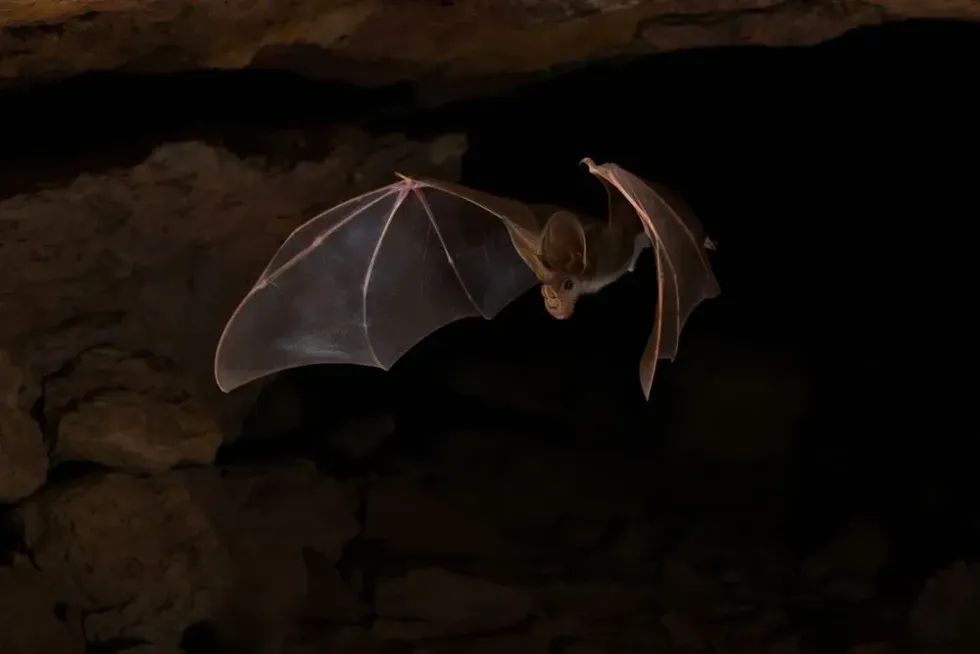Are you interested in learning about bats? The Northern ghost bat is a rare species and that makes it more interesting to read about the creature.
Let us get started with some tidbits which will give an insight into more fascinating facts to come. One of the most interesting features about these animals is that they are endothermic in nature. This means that the Northern ghost bat is one of those animals that can maintain its body temperature.
Hence, its body temperature remains the same irrespective of the temperature of the surroundings for the Northern ghost bat. Cold weather or hot weather do not affect them.
These animals also have a positive impact on the environment. They tend to feed on pests. As a result, they are instrumental in keeping agricultural lands intact and free of pests.
Moreover, because of their rarity, they have a tendency to attract tourists. However, there are some negative impacts as well, like the risk of any human contracting rabies from them.
Keep on reading to know more about these creatures! For more similar content, check out dhole facts and key deer facts.
Northern Ghost Bat Interesting Facts
What type of animal is a Northern ghost bat?
The Northern ghost bat (Diclidurus albus) is a type of bat, and are members of the family Emballonuridae.
What class of animal does a Northern ghost bat belong to?
The Northern ghost bats (Diclidurus albus) belong to the class Mammalia.
How many Northern ghost bats are there in the world?
The exact population of the Northern ghost bats (Diclidurus albus) remains unknown. It has been recorded that the population of ghost bats in general, stands at 2500-3500 in the Northern Territory in Australia.
Where does a Northern ghost bat live?
The Northern ghost bat (Diclidurus albus) can be found in North, Central, and South America. In North America, they can be seen in Mexico, while Brazil acts as the home to these bats in South America.
When it comes to Central America, Costa Rica is the home of this species. They are also native to a range within the Caribbean Islands, such as Trinidad.
What is a Northern ghost bat's habitat?
The Northern ghost bats (Diclidurus albus) are known to have a terrestrial and tropical habitat. This species thrives well in humid conditions.
As a result, rainforests and a range close to water bodies make up for their ideal habitat. However, they have been spotted in and around human habitats such as villages, vegetations, clearings, and more. Palm trees and their fronds make a suitable place where these bats like to roost.
At times, this bat species can also be found in evergreen forests or even deciduous forests. Northern ghost bats can be spotted at an elevated range that can measure up to 4921 ft (1500 m).
Who do Northern ghost bats live with?
The Northern ghost bat is a solitary species. They can only be seen in small groups during the mating or breeding season. They roost in groups of not more than four individuals. However, they are never seen gathering in large groups or what is commonly called colonies.
How long does a Northern ghost bat live?
The average Northern ghost bat life span remains unknown. However, other species of the ghost bat are known to survive for a period of 16-20 years in the wild. Hence, we can assume that the lifespan of the Northern ghost bat would also be in this range.
How do they reproduce?
This rare species is polygynous in nature, meaning the male of this species has more than one female partner. They mate annually.
Their breeding season takes place during the months of January and February. These otherwise solitary species roost with up to four other individuals during the mating season.
Generally, three females roost with a single male. A distinct phenomenon can be seen in the male where the gland located at the base of its tail, on its uropatagium swells.
The uropatagium is a membrane between their hind limbs, which helps these animals to fly. The swelling in this uropatagium facilitates attracting the female. After mating, the females of this species have been observed to be pregnant within the months that range from January to June.
Additionally, the young ones are typically born between the months of May and June. Their gestation period remains unknown.
There is no information on the weaning period of these animals. As they are quite a rare species, there has been not enough study to know about the age at which they attain sexual maturity.
What is their conservation status?
As per the International Union for Conservation of Nature (IUCN) Red List, these animals fall under the category of Least Concern. Although they are rare, their population seems to be stable. As a result, there is no potential risk to their numbers in the near future.
Northern Ghost Bat Fun Facts
What do Northern ghost bats look like?

The name of the Northern ghost bats comes partly from their appearance. They have hairy or furry skin, most of which is white in color.
In certain cases, it has been noticed that the tip of each hair on their bodies is white while their bases have grey coloration. As a result, the animal may often appear to be whitish-grey or ash grey in color. They have short tails.
The tail is about just a third of the uropatagium. The uropatagium, on the other hand, is mostly covered in fur and stretches further than the hind limbs.
Their faces, however, are devoid of any hair or fur. One of the most prominent parts of their physical appearance is their huge eyes, which play an important role in their physical description.
Their ears, on the other hand, are short and have a yellowish hue. They do not have any nose leaves. Unlike other species of the ghost bat, these creatures are devoid of any wing sacs.
Instead, they are featured with an unusual sac or gland at the uropatagium. Northern ghost bat wings span across 19.7 in (50 cm).
How cute are they?
Cute is definitely one way to describe the Northern ghost bat (Diclidurus albus). The Northern ghost bat has fur on its body which gives it a fluffy appearance. Their tiny face also makes them more adorable.
How do they communicate?
These animals belonging to the genus Diclidurus, communicate through sight, touch, ultrasound, and echolocation. They also use chemical signals to perceive.
Echolocation is used by them to track potential prey. These animals also use echolocation to find their way during the night. Northern ghost bat sounds include a distinct hunting call which is emitted at a frequency of 22 kHz.
How big is a Northern ghost bat?
The Northern ghost bat ranges from 3.4-4 in (86-103 cm) in length. They are about four times smaller than a black rat.
How fast can a Northern ghost bat fly?
The Northern ghost bat flying speed is not known. Generally, ghost bats are believed to be fast in their flight.
How much does a Northern ghost bat weigh?
On average, the Northern ghost bats weigh 0.6-0.8 oz (17-24 g).
What are the male and female names of the species?
There is no specific name for the male and female of this species. They are simply called a male Northern ghost bat and a female Northern ghost bat.
What would you call a baby Northern ghost bat?
A baby bat is called a pup. Groups of bats are known as colonies.
What do they eat?
Not much is known about the diet of these animals. They are known to be carnivorous in nature, insectivorous in particular. This means that they thrive by feeding on insects. Studies have shown that the contents of their stomachs indicate a high consumption of moths.
Are they poisonous?
No, these animals are not poisonous. On the contrary, they are practically harmless creatures.
Would they make a good pet?
Ideally, Northern ghost bat species do not make good pets. Even though these animals do not pose any threat to humans, they should not be kept in captivity. To begin with, they are wild creatures.
Hence, it is never a smart move to try to tame wild beings. Moreover, these animals require a big space in which to live and forage for food. Additionally, certain places have made it illegal to own these bats.
Did you know...
The migration route of the Northern ghost bats is restricted within the Neotropics. The Neotropic region comprises of South American as well as Central American geographic range. Southern Mexico and even the Caribbean Islands fall under this Neotropic region.
The Northern ghost bats can be seen roosting at old mines, caves, and rock crevices.
Are ghost bats endangered?
The conservation status of the ghost bats has been marked as Vulnerable by the International Union for Conservation of Nature (IUCN) Red List. It is so because their population is decreasing.
Such a decrease is owed to a loss in their natural habitat and climate change, coupled with the fight to obtain prey amidst competition with a number of other animals. Apart from these threats, the ghost bat has very few natural predators.
These include owls and snakes. However, conservation efforts are in place to maintain and subsequently increase their population.
Are Northern ghost bats nocturnal?
Yes, Northern ghost bats are nocturnal in nature. This means that they forage for prey at night.
Meanwhile, these animals spend the daytime roosting, which is resting under palm tree fronds. This nocturnal nature also doubles as a protection against a variety of predators who would have otherwise preyed on these bats on a larger scale during the daytime. Due to this nature, they have been termed ghosts.
Here at Kidadl, we have carefully created lots of interesting family-friendly animal facts for everyone to discover! Learn more about some other mammals from our deer facts and alpine ibex facts pages.
You can even occupy yourself at home by coloring in one of our free printable northern ghost bat coloring pages.










